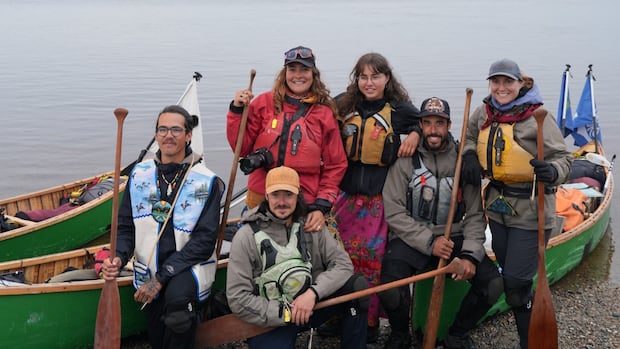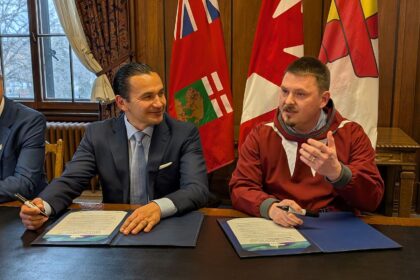NorthAfter more than 97 days of paddling and portaging, a team of canoeists have completed a 1,200-kilometer journey retracing the historic fur trade route from Tadoussac to Waskaganish, Que, and connecting with their ancestors and the land in the process.Journey tested travellers strength, patience and determinationVanna Blacksmith · CBC News · Posted: Sep 09, 2025 12:33 PM EDT | Last Updated: 5 hours agoSix paddlers arrive in Waskaganish, Que. on Sept 4, after 1,200 kilometres of retracing a fur trade route. (À la Mer du Nord/Facebook)After 97 days of paddling and portaging, a team of canoeists completed a 1,200-kilometre journey retracing a historic fur trade route from Tadoussac to Waskaganish, Que.The six paddlers — calling themselves À la Mer du Nord — tested their endurance while tracing the footsteps of Indigenous peoples and voyageurs from centuries past. They left Tadoussac on May 31 and arrived in Waskaganish on Sept. 4.”We can almost see the footprints of generations and generations of paddlers still there,” said Bruno Forest, the trip’s leader. The group crossed portage trails that had nearly vanished, cutting brush along the way, and paddled upstream on waterways rarely travelled.Bruno Forest, the lead of the project, said the trip was extremely physically demanding. (Submitted by Margault Demasles)”It was extremely exhausting,” Forest said.Originally there were nine paddlers in the group but various physical ailments forced three to leave early.Strong winds and poor conditions made stretches that were supposed to be easy paddling extremely challenging. On one day the group travelled only 800 metres upstream before setting up camp.The canoes themselves were put to the task too. The boats, built from cedar and canvas, were sturdy but not indestructible and over time tore in several places. That forced the team to bail out water that seeped in. Two of the canoes suffered broken ribs but ultimately made it through and Forest said travelling in those old cedar canoes was special in itself. “They were very good allies,” Forest said. “We saw them as companions. It was like they were participating in our adventure.” For participant Francis Bossum, a student at Kiuna College in Odanak studying First Nations’ languages, the challenges helped him feel connected to his roots.”The thing that kept going was thinking of my ancestors,” he said. “My ancestors did this route so many years before me. They did it, so I can do it too.”He said the journey taught him about his own tenacity and his desire to travel. “It really showed I can do anything I want and I have the guts, strength, patience to do everything the world has to offer,” he said.Bossum is Ilnu from Mashteuiatsh. He joined the group as one of the only Indigenous people for the majority of the trip and helped teach the rest of the travellers about Ilnu language and some traditional medicine. Throughout the trek, the team learned different ways of living on the land. That includes survival skills from residents of Mashteuiatsch, Old Nemaska, Mistissini, and Waskaganish.Francis Bossum said the trip taught him about his own tenacity and his desire to travel. (Submitted by Mathieu Ainsley)George Diamond, a member of Waskaganish’s elders’ council, said that welcoming the paddlers and seeing them meet community members at the end of their trip was special. “It felt good because it was like history was being repeated from the past,” he said. “Our ancestors must have paddled this journey thousands of times.” Diamond said he’s proud of the team for completing such a big journey.”It’s an accomplishment in itself. It’s a good memory that they’re gonna have forever,” he said.Documentary and book to comeThe six paddlers commemorated the journey with matching tattoos—an eagle soaring over spruce branches—a symbol of the guidance and protection they experienced along the route.Reflecting on the expedition, Forest said he still wants time to absorb its meaning, but the people he encountered stood out as the most memorable aspect.The six paddlers getting matching tattoos during their stay in Mistissini, a Cree community in northern Que. (À la Mer du Nord/Facebook)A documentary chronicling the expedition is slated for release in 2026, and Forest plans to write a book about the adventure. On top of the personal connections, Forest said the travellers’ shared feelings about the land stands out as meaningful too. “The land is a big home,” he said. “I think it’s the philosophy that we admire the most, and that’s what we felt meeting the communities.”ABOUT THE AUTHORVanna Blacksmith is two-spirit and Eenou-Anishinaabe Bear Clan from the Cree Nation of Mistissini with Ojibwe roots from Wiikwemikoong Unceded Territory. She is a journalist and part of CBC’s Indigenous Pathways first cohort. She currently resides in Kanien’kehá:ka territory of Tiohtià:ke, also known as Montreal.With files from Dorothy Stewart
Monday, 22 Dec 2025
Canada – The Illusion
Search
Have an existing account?
Sign In
© 2022 Foxiz News Network. Ruby Design Company. All Rights Reserved.
You May also Like
- More News:
- history
- Standing Bear Network
- John Gonzalez
- ᐊᔭᐦᑊ ayahp — It happened
- Creation
- Beneath the Water
- Olympic gold medal
- Jim Thorpe
- type O blood
- the bringer of life
- Raven
- Wás’agi
- NoiseCat
- 'Sugarcane'
- The rivers still sing
- ᑲᓂᐸᐏᐟ ᒪᐢᑿ
- ᐅᑳᐤ okâw — We remember
- ᐊᓂᓈᐯᐃᐧᐣ aninâpêwin — Truth
- This is what it means to be human.
- Nokoma











